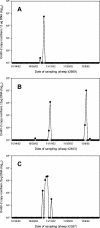Shedding of ovine herpesvirus 2 in sheep nasal secretions: the predominant mode for transmission
- PMID: 15583281
- PMCID: PMC535255
- DOI: 10.1128/JCM.42.12.5558-5564.2004
Shedding of ovine herpesvirus 2 in sheep nasal secretions: the predominant mode for transmission
Abstract
Ovine herpesvirus 2 (OvHV-2), the major causative agent of malignant catarrhal fever in ruminant species worldwide, has never been propagated in vitro. Using real-time PCR, a striking, short-lived, peak of viral DNA, ranging from 10(5) to over 10(8) copies/2 microg of DNA, was detected in nasal secretions from over 60.7% of adolescent sheep (n = 56) at some point during the period from 6 to 9 months of age. In contrast, only about 18% of adult sheep (n = 33) experienced a shedding episode during the study period. The general pattern of the appearance of viral DNA in nasal secretions was a dramatic rise and subsequent fall within 24 to 36 h, implying a single cycle of viral replication. These episodes occurred sporadically and infrequently, but over the 3-month period most of the 56 lambs (33, or 60.7%) experienced at least one episode. No corresponding fluctuations in DNA levels were found in either peripheral blood leukocytes or plasma. In a DNase protection assay, complete, enveloped OvHV-2 virions were demonstrated in the nasal secretions of all sheep examined during the time when they were experiencing an intense shedding episode. OvHV-2 infectivity in nasal secretions was also demonstrated by aerosolization of the secretions into OvHV-2-negative sheep. The data herein show that nasal shedding is the major mode of OvHV-2 transmission among domestic sheep and that adolescents represent the highest risk group for transmission.
Figures



Similar articles
-
Demonstration of sheep-associated malignant catarrhal fever virions in sheep nasal secretions.Virus Res. 2003 Dec;98(2):117-22. doi: 10.1016/j.virusres.2003.09.002. Virus Res. 2003. PMID: 14659558
-
Levels of ovine herpesvirus 2 DNA in nasal secretions and blood of sheep: implications for transmission.Vet Microbiol. 2001 Apr 19;79(4):301-10. doi: 10.1016/s0378-1135(00)00367-9. Vet Microbiol. 2001. PMID: 11267790
-
Experimental infection of sheep with ovine herpesvirus 2 via aerosolization of nasal secretions.J Gen Virol. 2005 Mar;86(Pt 3):575-579. doi: 10.1099/vir.0.80707-0. J Gen Virol. 2005. PMID: 15722516
-
[Virus in sheep's skin].Schweiz Arch Tierheilkd. 2005 Apr;147(4):155-64. doi: 10.1024/0036-7281.147.4.155. Schweiz Arch Tierheilkd. 2005. PMID: 15861922 Review. German.
-
The pathology of malignant catarrhal fever, with an emphasis on ovine herpesvirus 2.Vet Pathol. 2014 Mar;51(2):437-52. doi: 10.1177/0300985813520435. Epub 2014 Feb 5. Vet Pathol. 2014. PMID: 24503439 Review.
Cited by
-
Long distance spread of malignant catarrhal fever virus from feedlot lambs to ranch bison.Can Vet J. 2008 Feb;49(2):183-5. Can Vet J. 2008. PMID: 18309750 Free PMC article.
-
Field Observations and Genetic Characterization of Sheep-Associated Malignant Catarrhal Fever in Egypt, 2018.Vet Sci. 2020 Dec 11;7(4):201. doi: 10.3390/vetsci7040201. Vet Sci. 2020. PMID: 33322397 Free PMC article.
-
Identification and Prevalence of Phascolarctid Gammaherpesvirus Types 1 and 2 in South Australian Koala Populations.Viruses. 2020 Aug 27;12(9):948. doi: 10.3390/v12090948. Viruses. 2020. PMID: 32867109 Free PMC article.
-
Molecular Analysis of South African Ovine Herpesvirus 2 Strains Based on Selected Glycoprotein and Tegument Genes.PLoS One. 2016 Mar 22;11(3):e0147019. doi: 10.1371/journal.pone.0147019. eCollection 2016. PLoS One. 2016. PMID: 27002629 Free PMC article.
-
Sheep associated malignant catarrhal fever: an emerging disease of bovids in India.Indian J Virol. 2013 Dec;24(3):321-31. doi: 10.1007/s13337-013-0163-y. Epub 2013 Sep 21. Indian J Virol. 2013. PMID: 24426294 Free PMC article.
References
-
- Baxter, S. I. F., I. Pow, A. Bridgen, and H. W. Reid. 1993. PCR detection of the sheep-associated agent of malignant catarrhal fever. Arch. Virol. 132:145-159. - PubMed
-
- Baxter, S. I. F., A. Wiyono, I. Pow, and H. W. Reid. 1997. Identification of ovine herpesvirus-2 infection in sheep. Arch. Virol. 142:823-831. - PubMed
-
- Borza, C. M., and L. M. Hutt-Fletcher. 2002. Alternate replication in B cells and epithelial cells switches tropism of Epstein-Barr virus. Nat. Med. 8:594-599. - PubMed
-
- Crawford, T., D. T. O'Toole, and H. Li. 1999. Malignant catarrhal fever, p. 306-309. In J. Howell and R. A. Smith (ed.), Current veterinary therapy 4: food animal practice. W.B. Saunders Company, Philadelphia, Pa.
-
- Harris, R. E., K. H. Christiansen, and M. H. Blunt. 1978. Observations on the epidemiology of malignant catarrhal fever. N. Z. Vet. J. 26:86-87. - PubMed
Publication types
MeSH terms
LinkOut - more resources
Full Text Sources

